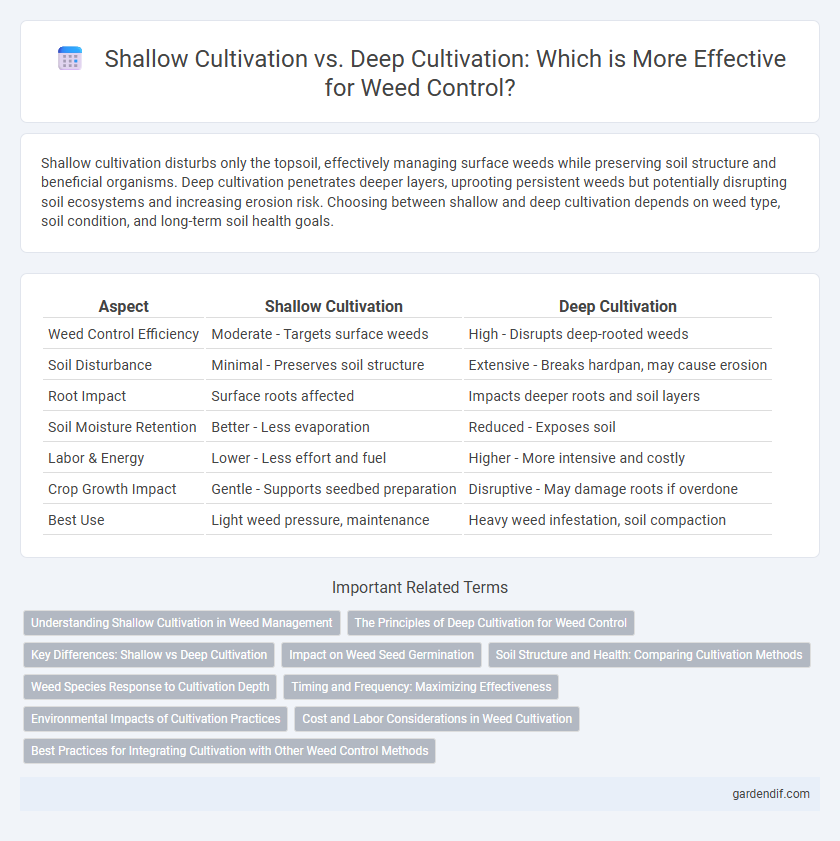
Shallow cultivation vs Deep cultivation Illustration
Shallow cultivation disturbs only the topsoil, effectively managing surface weeds while preserving soil structure and beneficial organisms. Deep cultivation penetrates deeper layers, uprooting persistent weeds but potentially disrupting soil ecosystems and increasing erosion risk. Choosing between shallow and deep cultivation depends on weed type, soil condition, and long-term soil health goals.
Table of Comparison
| Aspect | Shallow Cultivation | Deep Cultivation |
|---|---|---|
| Weed Control Efficiency | Moderate - Targets surface weeds | High - Disrupts deep-rooted weeds |
| Soil Disturbance | Minimal - Preserves soil structure | Extensive - Breaks hardpan, may cause erosion |
| Root Impact | Surface roots affected | Impacts deeper roots and soil layers |
| Soil Moisture Retention | Better - Less evaporation | Reduced - Exposes soil |
| Labor & Energy | Lower - Less effort and fuel | Higher - More intensive and costly |
| Crop Growth Impact | Gentle - Supports seedbed preparation | Disruptive - May damage roots if overdone |
| Best Use | Light weed pressure, maintenance | Heavy weed infestation, soil compaction |
Understanding Shallow Cultivation in Weed Management
Shallow cultivation in weed management involves tilling the soil to a limited depth, typically less than 5 centimeters, which helps disrupt the weed seed germination zone without bringing dormant seeds to the surface. This method reduces weed emergence by targeting seedlings while preserving soil structure and minimizing moisture loss. Understanding shallow cultivation techniques allows farmers to effectively manage weed populations with lower energy input and reduced soil erosion compared to deep cultivation practices.
The Principles of Deep Cultivation for Weed Control
Deep cultivation disrupts weed root systems by penetrating soil beyond superficial layers, effectively uprooting established weeds and preventing regrowth. This method enhances soil aeration and moisture retention, promoting healthy crop development while suppressing weed seed germination. By targeting weeds at deeper soil strata, deep cultivation reduces reliance on herbicides and supports sustainable weed management.
Key Differences: Shallow vs Deep Cultivation
Shallow cultivation targets the topsoil layer, effectively disrupting weed seedlings without disturbing deeper soil layers, which helps maintain soil structure and moisture. Deep cultivation penetrates beyond the surface, uprooting deeper weed roots and significantly altering soil profiles, but it may increase soil erosion and disrupt beneficial microorganisms. Choosing between shallow and deep cultivation depends on weed species, soil health, and long-term crop management goals.
Impact on Weed Seed Germination
Shallow cultivation stimulates weed seed germination by exposing seeds to light and optimal temperature conditions near the soil surface, leading to higher weed emergence. Deep cultivation buries weed seeds at greater depths, reducing oxygen availability and light exposure, which suppresses germination and decreases weed seedling emergence. Selecting the appropriate cultivation depth is crucial for managing the weed seed bank and minimizing weed pressure in agricultural systems.
Soil Structure and Health: Comparing Cultivation Methods
Shallow cultivation preserves soil structure by minimizing disruption to microbial communities and reducing erosion, which supports healthier soil ecosystems. Deep cultivation often breaks up compacted layers but can destroy soil aggregates and decrease organic matter, leading to long-term soil degradation. Choosing shallow cultivation methods promotes soil stability and sustained fertility essential for effective weed control and crop production.
Weed Species Response to Cultivation Depth
Weed species exhibit varying responses to shallow versus deep cultivation, largely influenced by their seed size, dormancy, and growth strategy. Small-seeded species like lamb's quarters and pigweed thrive after shallow cultivation, as their seeds remain near the soil surface, promoting germination. Deep cultivation often buries these seeds too far for successful emergence but may stimulate the growth of larger-seeded weeds such as Canada thistle and quackgrass, which can survive and exploit deeper soil layers.
Timing and Frequency: Maximizing Effectiveness
Shallow cultivation is most effective when performed frequently and early in the weed growth cycle, disrupting young seedlings before they establish strong roots. Deep cultivation should be timed carefully to avoid damaging crop roots, typically done less often and during specific crop growth stages for maximum weed control. Optimizing the balance between timing and frequency in shallow versus deep cultivation enhances overall weed management efficiency and minimizes crop stress.
Environmental Impacts of Cultivation Practices
Shallow cultivation minimizes soil disturbance, reducing erosion, preserving soil structure, and maintaining beneficial microorganisms, which support sustainable weed management. Deep cultivation disrupts soil layers, accelerating organic matter decomposition and increasing carbon dioxide emissions, contributing to greenhouse gas effects. By preserving soil integrity, shallow cultivation promotes long-term environmental health and reduces negative impacts associated with intensive agricultural practices.
Cost and Labor Considerations in Weed Cultivation
Shallow cultivation in weed cultivation requires less labor and incurs lower costs due to reduced soil disturbance and simpler equipment needs, making it ideal for small-scale or budget-conscious growers. Deep cultivation demands higher labor input and increased machinery use, elevating overall costs but potentially improving weed control and soil aeration in larger operations. Choosing between shallow and deep cultivation balances labor availability and cost constraints with the desired weed management outcomes.
Best Practices for Integrating Cultivation with Other Weed Control Methods
Shallow cultivation disrupts weed seedlings near the soil surface without harming crop roots, making it ideal for early weed control in row crops; deep cultivation penetrates further, uprooting established weeds but risks damaging crops if not carefully timed. Best practices integrate shallow cultivation with mulching, cover crops, and targeted herbicide application to maximize weed suppression while preserving soil health. Combining cultivation depth and timing with crop rotation and hand weeding enhances overall weed management efficacy by reducing weed seed banks and preventing resistance buildup.
Shallow cultivation vs Deep cultivation Infographic

 gardendif.com
gardendif.com